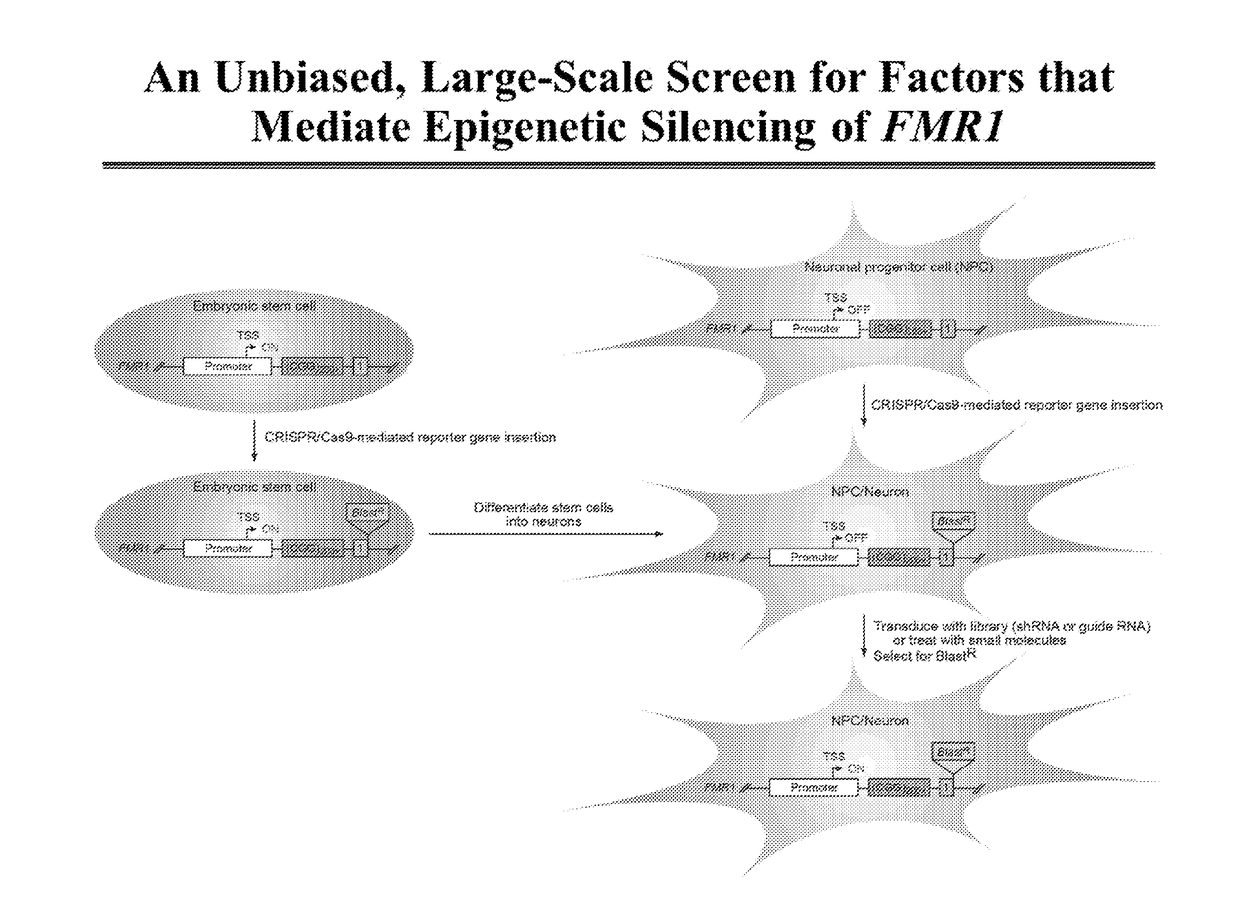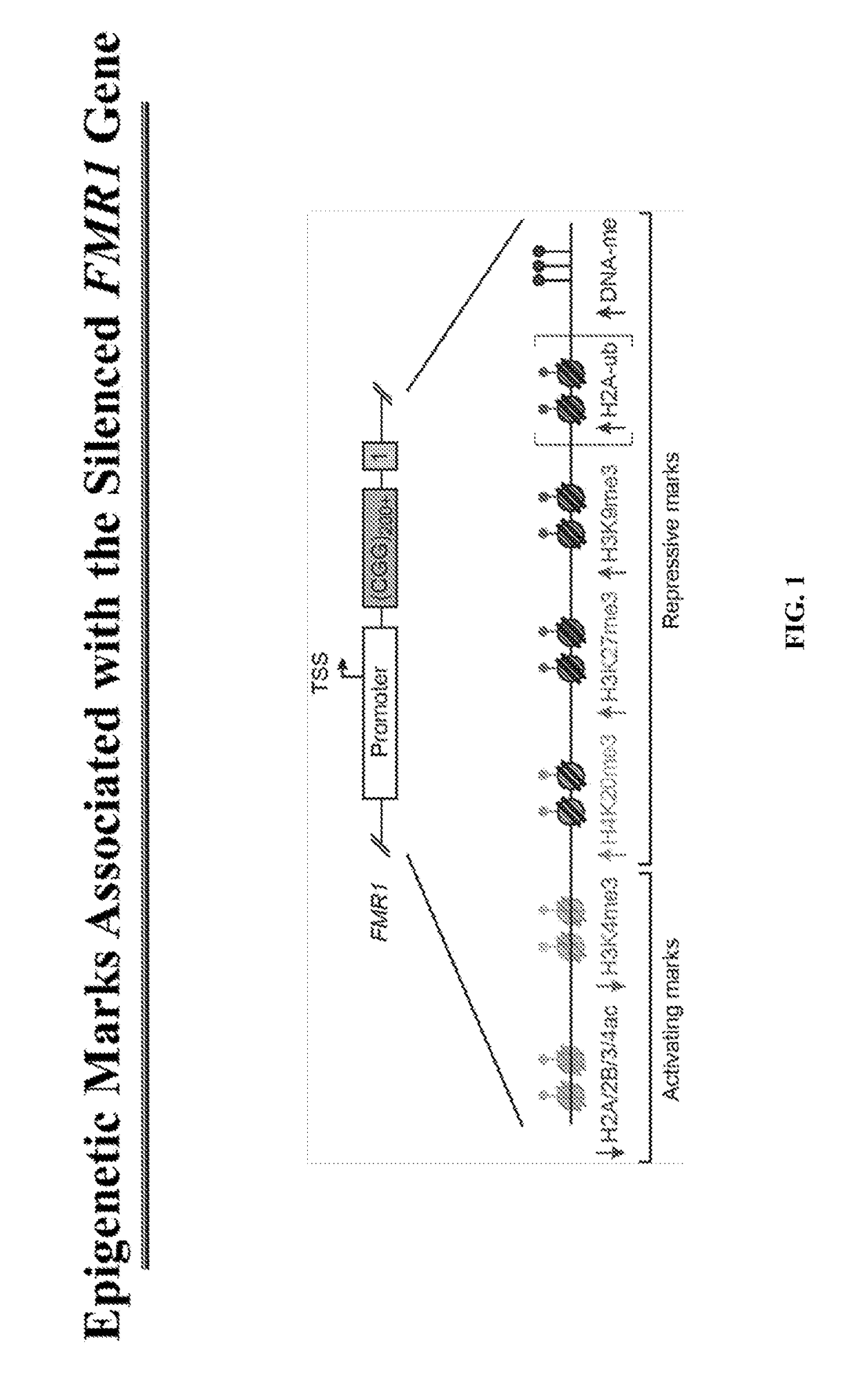Compositions and methods for modulating fmr1 expression
a technology of gene expression and expression, applied in the direction of transferases, peptide/protein ingredients, antibody medical ingredients, etc., can solve the problem of lack of fragile x mental retardation protein (fmrp), and achieve the effect of increasing fmr1 expression, reducing disease symptomatology, and more permisive chromatin sta
- Summary
- Abstract
- Description
- Claims
- Application Information
AI Technical Summary
Benefits of technology
Problems solved by technology
Method used
Image
Examples
example 1
[0132]Factors responsible for depositing repressive marks or for removing activating marks are potential targets to reactivate the epigenetically silenced FMR1 gene (FIG. 2). The following table (Table 3) is a non-comprehensive list of factors responsible for depositing or removing the epigenetic marks on the silenced FMR1 gene.
TABLE 3Potential Chromatin Modifier Targetsfor Epigenetic Modulators of FMR1Epigenetic markPotential target(s)DNAmeDNMT1, DNMT3A, DNMT3BH3K27me3EZH2H3K9me3SETDB1, EHMT1 / GLP, EHMT2 / G9a, SUV39H1H4K20me3SUV420H1, SUV420H2H2AubRING1B / RNF2H2A / 2B / 3 / 4acHDAC1-10, SIRT1-7H3K4me3KDM5A-D
[0133]All of the factors required for depositing or removing the epigenetic marks mentioned in the above table have been systematically knocked down using short hairpin RNAs (shRNAs) (FIG. 3). These experiments were performed in induced pluripotent stem cells (iPSCs) derived from an FXS patient. FXS iPSCs harbor a repressed FMR1 gene, and therefore serve as a useful model system for stud...
example 2
[0136]A large-scale RNAi screen, using genome-wide libraries and / or kinase or transcription factor sub-libraries, is performed to identify new factors that mediate epigenetic silencing of FMR1 (FIG. 5). For this screen, a reporter cell line is derived, containing a blasticidine reporter gene (BlastR) positioned downstream of an inactivated FMR1 gene. Reactivation of the FMR1 gene by an epigenetic modulator of FMR1 induces expression of the BlastR gene and enables the isolation of positive candidates by drug selection. As shown in FIG. 5, the BlastR gene can be inserted into the FMR1 gene using a CRISPR / Cas9 system.
example 3
te-Based Screen Identifies Epigenetic Regulators that Mediate Silencing of FMR1 in Patient-Derived Induced Pluripotent Stem Cells (iPSCs)
[0137]To identify epigenetic regulators that mediate silencing of FMR1, a small-scale short hairpin RNA (shRNA) library comprising 162 shRNAs directed against 33 well-characterized epigenetic regulators that mediate transcriptional repression was assembled. Each shRNA was packaged into lentivirus and transduced into an undifferentiated FXS iPSC line (FXS 848-iPS3 cells). Twenty days post-transfection, mRNA was prepared and FMR1 expression analyzed by quantitative RT-PCR (qRT-PCR). Positive results were considered to be statistically significant increases in FMR1 expression with at least two unrelated shRNAs directed against the same target compared to that obtained with a control non-silencing (NS) shRNA. The results of FIG. 4A identified nine epigenetic regulators of the silenced FMR1 gene: DNMT1, EZH2, RNF2 (also called RING1B), SUV39H1, KDM5C, K...
PUM
| Property | Measurement | Unit |
|---|---|---|
| Electric charge | aaaaa | aaaaa |
| Level | aaaaa | aaaaa |
Abstract
Description
Claims
Application Information
 Login to View More
Login to View More - R&D
- Intellectual Property
- Life Sciences
- Materials
- Tech Scout
- Unparalleled Data Quality
- Higher Quality Content
- 60% Fewer Hallucinations
Browse by: Latest US Patents, China's latest patents, Technical Efficacy Thesaurus, Application Domain, Technology Topic, Popular Technical Reports.
© 2025 PatSnap. All rights reserved.Legal|Privacy policy|Modern Slavery Act Transparency Statement|Sitemap|About US| Contact US: help@patsnap.com



